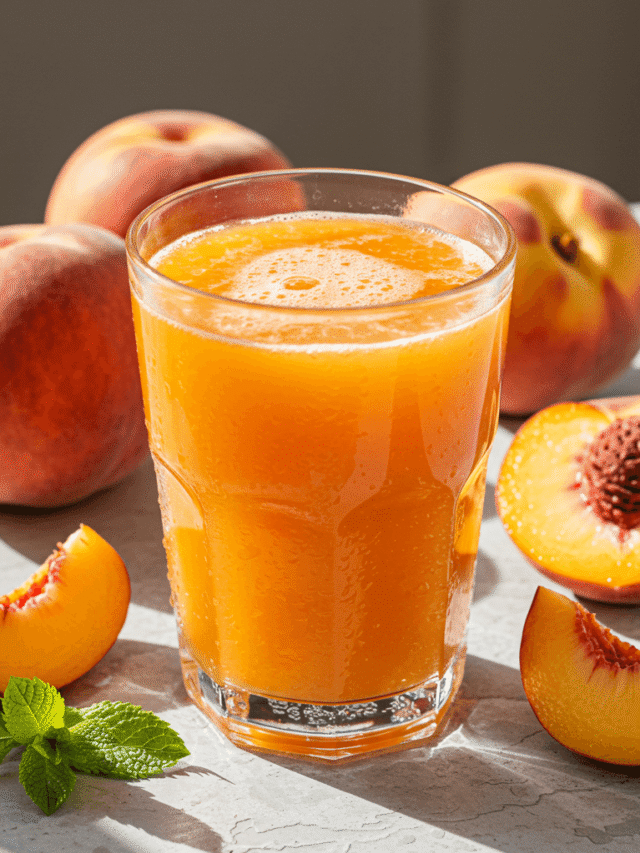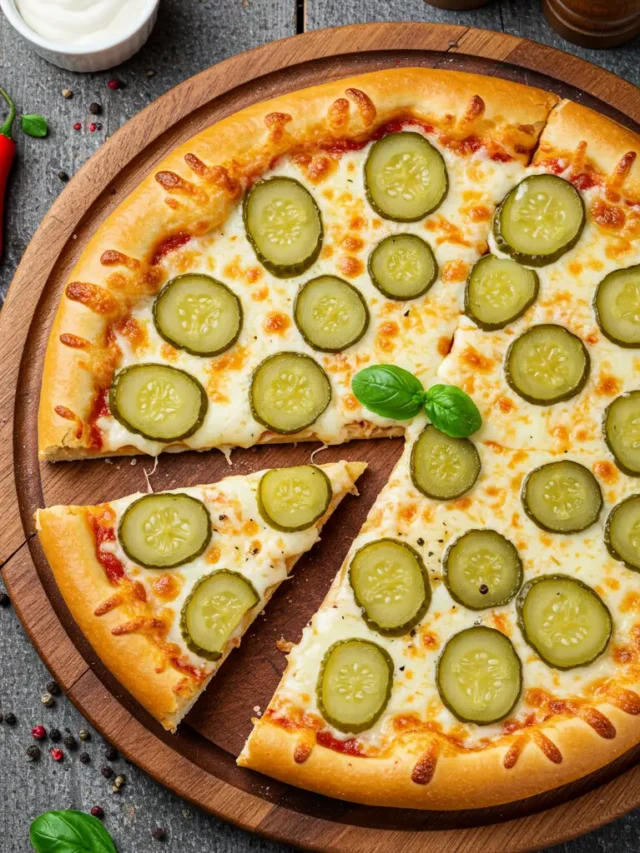Introduction
Making pizza dough at home brings joy and satisfaction that takeout simply can’t match. The smell of fresh bread baking, the bubbling cheese, and that first bite of a hot slice made with your own hands creates an experience worth mastering. King Arthur Baking Company stands as one of the most trusted names in home baking, known for high-quality flours and tested recipes that work every time.
This guide will walk you through creating the best homemade pizza dough using King Arthur flour. If you’re searching for the ultimate King Arthur pizza dough recipe, you’re in the right place. We’ll share tips from professional pizza-making guides that transform ordinary dough into something special. The right techniques make all the difference—from how you mix the ingredients to the way you shape your crust. With a scientific approach to perfect pizza, even beginners can make restaurant-quality pizza on their first try.
Whether you want a thin, crispy New York-style crust or a thick, chewy Sicilian square, the basics remain the same. Great pizza dough starts with quality ingredients and simple but exact methods. This article breaks down everything you need to know, from choosing the right flour to storing extra dough for later use. We’ll also show how these pizza-making skills connect with other baking projects like the perfect accompaniment to homemade pizza such as garlic knots. So if you’re looking to master a King Arthur pizza dough recipe, this comprehensive guide is the perfect place to start.
The Perfect King Arthur Pizza Dough Recipe Base
Choosing the Right King Arthur Flour
The flour choice for your pizza dough affects everything about your finished pizza. King Arthur offers several options, each creating different results:
- King Arthur Bread Flour (12.7% protein): Creates a chewy, sturdy crust that holds up to heavy toppings
- King Arthur All-Purpose Flour (11.7% protein): Makes a balanced crust with good chew and crisp edges
- King Arthur 00 Pizza Flour (11.5% protein): Produces authentic Italian-style crusts that cook quickly at high heat
The protein percentage matters because it determines how much gluten forms in your dough. More gluten means more stretch and chew. For New York-style pizza, bread flour works best. For Neapolitan-style thin crust, the 00 flour shines. Understanding these differences puts you ahead in your pizza journey, and you can learn more about understanding flour protein content for all your baking needs.
Most home bakers keep all-purpose flour on hand, which makes very good pizza. But if you make pizza often, try bread flour for that authentic pizzeria chew. The best part? You can mix flours to create your perfect custom blend. With this King Arthur pizza dough recipe, you’ll have a strong foundation for delicious, reliable homemade pizza every time.
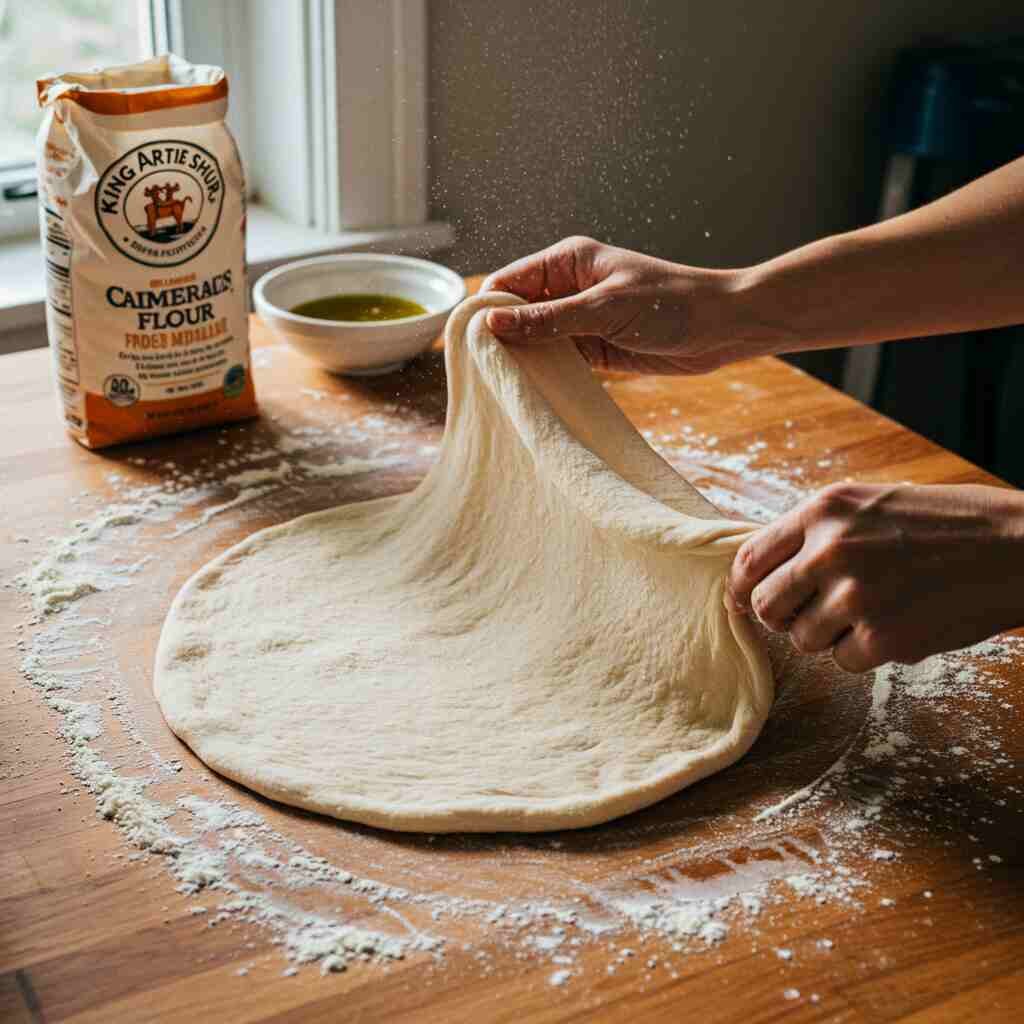
Essential Ingredients for king arthur pizza dough recipe
Great pizza dough needs only a few ingredients, but each plays a critical role:
- Flour: The foundation that gives structure and texture
- Water: Activates gluten and creates steam during baking
- Salt: Adds flavor and controls yeast activity
- Yeast: Creates rise through fermentation
- Oil: Adds tenderness and helps browning (optional but recommended)
- Sugar: Feeds yeast and helps browning (optional)
King Arthur’s pizza dough flavor enhancer contains dried milk, garlic, and herbs that add depth to basic dough. You can make something similar at home by adding a teaspoon of garlic powder and Italian herbs to your flour.
The hydration level (percentage of water to flour by weight) changes your results dramatically. Lower hydration (55-60%) creates firm, easy-to-handle dough. Higher hydration (65-70%) makes more open, airy crust but feels stickier when working with it.
For beginners, start with this reliable basic pizza dough recipe:
- 3 cups (360g) King Arthur Bread Flour
- 1 cup plus 2 tablespoons (255g) warm water
- 2 tablespoons olive oil
- 1½ teaspoons salt
- 2 teaspoons instant yeast
- 1 tablespoon honey or sugar (optional)
This makes enough for two 12-inch pizzas with perfect texture. If you want to add more flavor with herbs, check out this guide on storing fresh herbs for pizza toppings so nothing goes to waste.
Classic King Arthur Pizza Dough Recipe
Step-by-Step Mixing Process
Making pizza dough is more about technique than complicated ingredients. Follow these steps for perfect results every time using a King Arthur pizza dough recipe that delivers great taste and texture:
- Measure accurately – For best results, weigh your ingredients with a kitchen scale
- Mix dry ingredients first – Combine flour, salt, and any dry seasonings
- Add wet ingredients – Pour in water, oil, and any liquid flavors
- Mix until shaggy – Stir just until no dry flour remains
- Rest 15 minutes – This short pause helps flour absorb water (called autolyse)
- Knead the dough – Develop gluten through 5–8 minutes of kneading
You’ll know your dough has enough gluten development when it passes the “windowpane test.” Take a small piece and stretch it gently between your fingers. If it stretches thin enough to see light through without tearing, your dough is ready.
Hand kneading works perfectly for pizza dough, but a stand mixer with a dough hook speeds things up. With a mixer, start on low speed until ingredients combine, then switch to medium-low for 5–6 minutes. The dough should pull away from the sides of the bowl but still stick slightly to the bottom.
Many pizza experts recommend tested pizza techniques that include minimal handling of the dough after kneading. Less handling keeps air bubbles intact, creating that prized open crumb structure in your finished crust. These steps are essential to mastering a reliable and delicious King Arthur pizza dough recipe.
Fermentation and Rising
After kneading, the real magic happens during fermentation. This process creates flavor and improves texture in several ways:
- Yeast produces carbon dioxide that makes the dough rise
- Enzymes break down starches into sugars for better browning
- Bacteria create subtle sour notes that add depth
- Gluten relaxes, making the dough easier to shape
Place your dough in a lightly oiled bowl and cover it with plastic wrap or a damp towel. For a basic rise, leave it at room temperature (70–75°F) for about 1–2 hours until doubled in size.
The real secret to an outstanding King Arthur pizza dough recipe? Cold fermentation. After kneading:
- Cover dough and let it rise at room temperature for 1 hour
- Divide into individual pizza-sized balls (about 250g each)
- Place each ball in a lightly oiled container with room to expand
- Refrigerate for 24–72 hours
This slow, cold rise develops complex flavors similar to sourdough bread. The longer the dough stays in the fridge, the more tangy and complex it becomes. For the best balance of flavor and texture, aim for a 48-hour refrigeration.
When you’re ready to make pizza, take the dough out of the fridge about 1–2 hours before baking to warm up. Cold dough fights back when you try to stretch it, while room-temperature dough spreads more easily.
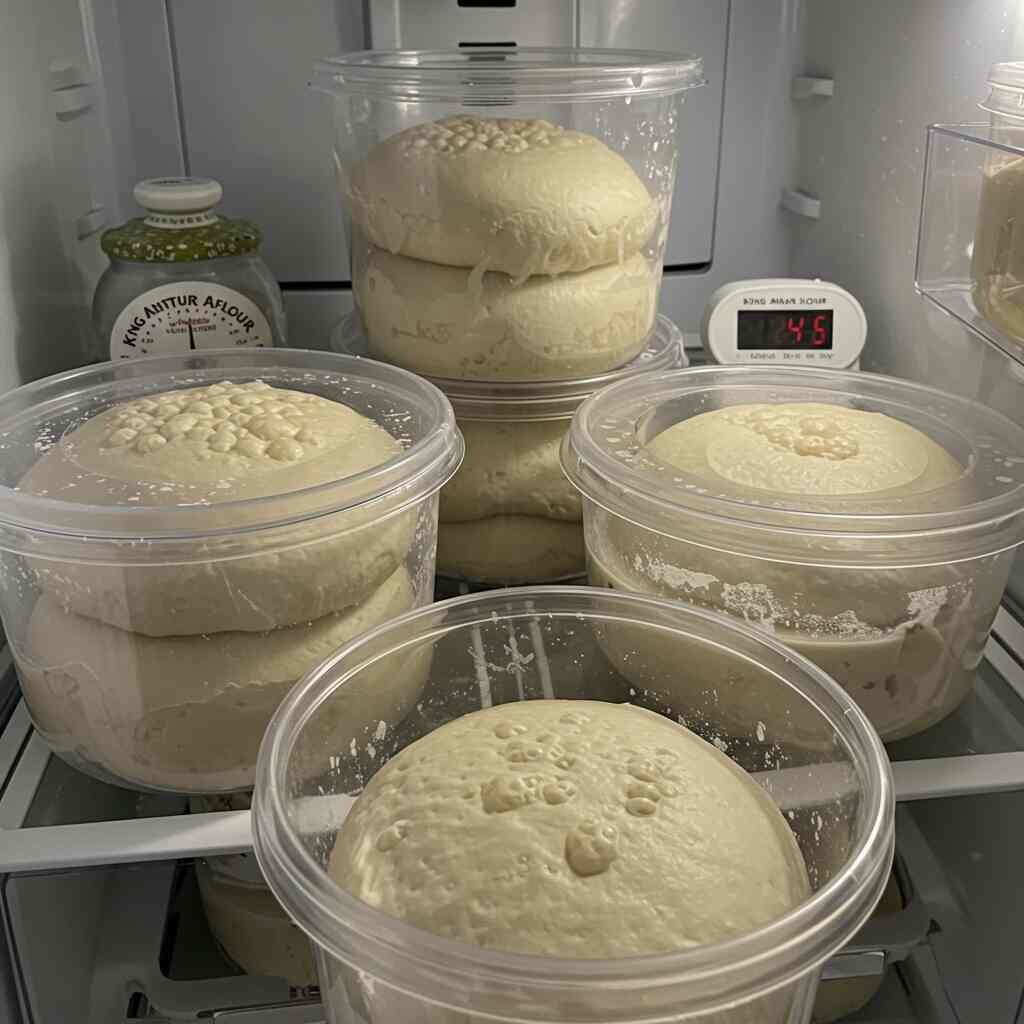
Advanced Techniques for Perfect Pizza Dough
The Science of Hydration: The 55 Rule Explained
The 55 rule refers to a hydration percentage that many pizza makers consider ideal for home ovens. In baker’s math, it means using water that equals 55% of the flour weight.
For example:
- 500g flour × 55% = 275g water
- 3 cups flour (360g) × 55% = 198g water (about ¾ cup + 2 Tbsp)
This hydration level creates dough that’s:
- Easy to handle without sticking
- Strong enough to stretch without tearing
- Bakes crisp on the outside, chewy inside
Higher hydration (65–70%) creates more open, airy crusts but requires more skill to handle. For beginners using a King Arthur pizza dough recipe, start with 55–58% hydration and gradually increase as you gain confidence.
Water temperature also matters. Use warm water (95–105°F) for same-day pizza, or cool water (65–70°F) for long fermentation. The right water temperature helps control how fast or slow your dough rises.
For those who love cooking with durable equipment, using cast iron for pizza making creates amazing crispy crusts that rival brick ovens.
Cold Fermentation Methods
Cold fermentation transforms good pizza dough into great pizza dough. The benefits include:
- Deeper flavor development
- Easier digestion (enzymes break down proteins)
- Better browning during baking
- Improved gas retention for better rise
- More relaxed gluten for easier shaping
For best results with King Arthur flour, try this cold fermentation schedule as part of your go-to King Arthur pizza dough recipe:
- Mix and knead dough as normal
- Let rise at room temperature for 1 hour
- Shape into balls, place in containers with lids
- Refrigerate for the desired time:
- 24 hours: Mild flavor improvement
- 48 hours: Noticeable complexity, ideal balance
- 72 hours: Maximum flavor, slightly more sour notes
The dough will rise slowly in the refrigerator, sometimes doubling in volume. Make sure your containers have enough room, or the dough might push the lids off!
Adding flavored oils for pizza dough enhancement can take your cold-fermented dough to the next level with herbs and garlic infused right into the crust—another way to personalize your King Arthur pizza dough recipe for incredible flavor and character.
Shaping and Stretching Techniques
The way you handle your dough after fermentation greatly affects your final crust. Many beginners make the mistake of using a rolling pin, which forces out the valuable gas bubbles your dough developed during fermentation—especially when following a King Arthur pizza dough recipe.
For the best texture, follow these hand-stretching steps:
- Take your dough out of the refrigerator 1–2 hours before shaping
- Place it on a lightly floured surface and press gently to flatten
- Start from the center and push outward, leaving the edge thicker
- Lift the dough and let gravity help stretch it
- Rotate as you go to maintain a circular shape
- Stop when you reach your desired thickness
Professional pizza makers use a technique called dough slapping, where they toss the dough in the air. This looks impressive but serves a purpose: the spinning motion helps the dough stretch evenly in all directions.
For beginners working with a King Arthur pizza dough recipe, try this easier countertop method:
- Flour your hands lightly, not the dough (too much flour makes tough crust)
- Press from the center with your fingertips, not your palms
- Leave a ½-inch border around the edge untouched for a puffy rim
- Pick up and drape the dough over your knuckles to stretch
- Let gravity do most of the work
If your dough keeps springing back, it needs to rest longer. Cover it with a kitchen towel and wait 10–15 minutes, then try again. The gluten will relax, making stretching easier.
Specialized King Arthur Pizza Dough Variations
New York-Style Pizza Dough
New York-style pizza features a thin crust with a crispy exterior and chewy interior that folds without breaking. For an authentic experience, this King Arthur pizza dough recipe uses high-protein flour and cold fermentation.
Ingredients:
- 4 cups (480g) King Arthur Bread Flour
- 1½ cups (340g) cool water (about 70% hydration)
- 2 teaspoons salt
- 1 teaspoon instant yeast
- 2 tablespoons olive oil
- 1 tablespoon sugar
Key techniques:
- Mix with slightly cooler water
- Knead longer (8–10 minutes) for maximum gluten development
- Cold ferment for at least 24 hours, preferably 48–72
- Bake at the highest temperature your home oven reaches
- Use a pizza stone or steel preheated for at least 45 minutes
This version of the King Arthur pizza dough recipe gives you the foldable, chewy texture of a classic New York slice. The sugar in the dough supports better browning in home ovens.
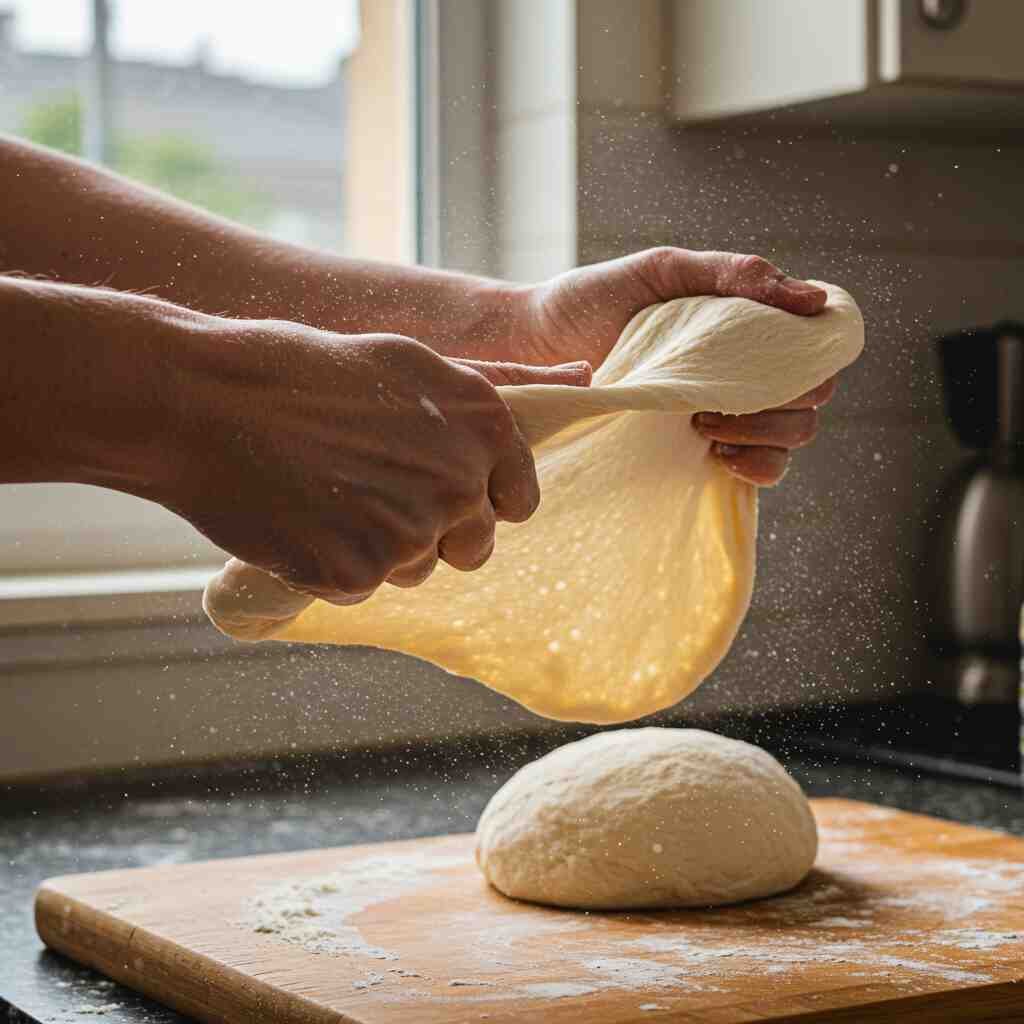
Sicilian and Detroit-Style Deep Dish
Pan pizzas like Sicilian and Detroit-style rely on high hydration doughs and generous olive oil. This King Arthur pizza dough recipe variation creates light, airy interiors and crisp bottoms.
Ingredients:
- 4 cups (480g) King Arthur Bread Flour
- 1¾ cups (395g) water (about 82% hydration)
- 2 teaspoons salt
- 1 teaspoon instant yeast
- 3 tablespoons olive oil (plus more for the pan)
Detroit-style tips:
- Use a blue steel or anodized aluminum pan
- Oil the pan generously before adding dough
- Push the dough into the corners with oiled fingertips
- Let rise in the pan for 1–2 hours before baking
- Place cheese all the way to the edges for crispy cheese crust
Sicilian-style pizza can be made in a rimmed baking sheet. Dimple the surface with your fingertips before topping—this signature step enhances the rustic, bubbly texture.
Thin and Crispy Pizza Crust
For fans of cracker-thin crusts, this variation of the King Arthur pizza dough recipe emphasizes minimal rise and low hydration.
Ingredients:
- 2½ cups (300g) King Arthur All-Purpose Flour
- ¾ cup (170g) water (about 57% hydration)
- 2 tablespoons olive oil
- 1 teaspoon salt
- 1 teaspoon instant yeast
- ½ teaspoon sugar
Key techniques:
- Mix ingredients just until combined
- Knead briefly—2–3 minutes max
- Rest 30 minutes only
- Roll thin (⅛ inch) with a rolling pin
- Dock the dough with a fork to prevent bubbles
- Pre-bake 3–4 minutes before topping
This version is perfect for those who prefer a crisp, uniform crust. It’s one of the easiest adaptations of the King Arthur pizza dough recipe, especially when you’re short on time.
Brushing olive oil on the edges before baking can enhance crunch and flavor, making even a thin crust shine.
Gluten-Free Pizza Options with King Arthur
Creating gluten-free pizza dough that tastes great presents unique challenges. The good news? King Arthur’s gluten-free flour blend makes it much easier to achieve excellent results with a gluten-free adaptation of a King Arthur pizza dough recipe.
Ingredients:
- 2 cups (296g) King Arthur Gluten-Free Measure for Measure Flour
- 1 tablespoon instant yeast
- 1 tablespoon sugar
- 1½ teaspoons xanthan gum (if your blend doesn’t include it)
- 1 teaspoon salt
- 1 tablespoon olive oil
- 1 cup (227g) warm water
Key differences from regular dough:
- Gluten-free dough won’t feel elastic like wheat dough
- The texture resembles thick cake batter more than traditional dough
- You’ll spread it in the pan rather than stretch it
- Pre-baking the crust before adding toppings works best
To make a gluten-free King Arthur pizza dough recipe work well, follow these special techniques:
- Mix all dry ingredients thoroughly before adding wet ingredients
- Beat the mixture with a stand mixer for 3–4 minutes to add air
- Let the dough rest for only 30 minutes (it won’t rise much)
- Spread directly in an oiled pan using wet fingers or a spatula
- Pre-bake for 10 minutes before adding toppings
- Finish baking until the edges turn golden brown
The resulting crust won’t have the exact same chew as wheat-based pizza, but with this King Arthur pizza dough recipe, you’ll get a flavorful, sturdy crust that holds up to toppings without falling apart.
Baking the Perfect Pizza
Oven Considerations and Setup
Your home oven setup makes a huge difference in pizza quality. Professional pizza ovens reach 800–900°F, while most home ovens max out around 550°F. We need to work with what we have.
Try these methods to get the hottest possible baking environment:
- Preheat your oven for at least 45–60 minutes
- Place your stone or steel on the middle or upper-middle rack
- Turn to the highest temperature setting (usually 500–550°F)
- Switch to broiler for the last minute of baking for extra browning
- Keep the oven door closed as much as possible
The best pizza baking surfaces, in order of performance:
- Baking steel – Conducts heat extremely well, creates the best crust
- Pizza stone – Great heat retention, slightly less conductive than steel
- Inverted baking sheet – Works in a pinch, preheat for 30+ minutes
- Pizza pan – Use one with holes for better air circulation
For any King Arthur pizza dough recipe, the key to crispy crust is the quick transfer of intense heat to the dough. This creates the perfect contrast between a crisp exterior and soft interior.
Temperature and Timing Guidelines
Different pizza styles need different temperatures for best results:
- Neapolitan/thin crust: Highest possible setting (500–550°F), 4–7 minutes
- New York-style: 475–500°F, 7–10 minutes
- Pan/Detroit-style: 450–475°F, 12–15 minutes
- Thin and crispy: 475°F, pre-bake 3 minutes, then 5–7 minutes with toppings
Visual cues tell you when your pizza reaches perfection:
- The edge crust shows golden-brown spots
- The bottom has darker brown areas but no black spots
- Cheese bubbles completely with some light browning
- The rim puffs up with visible air pockets
- You can lift the pizza and the center stays firm
Whichever King Arthur pizza dough recipe you use, monitor your first bake carefully. Every oven behaves differently, so fine-tuning your process may take a few tries.
Common Baking Problems and Solutions
Even with the best King Arthur pizza dough recipe, you might face these common pizza baking issues:
Problem: Undercooked center with burnt edges
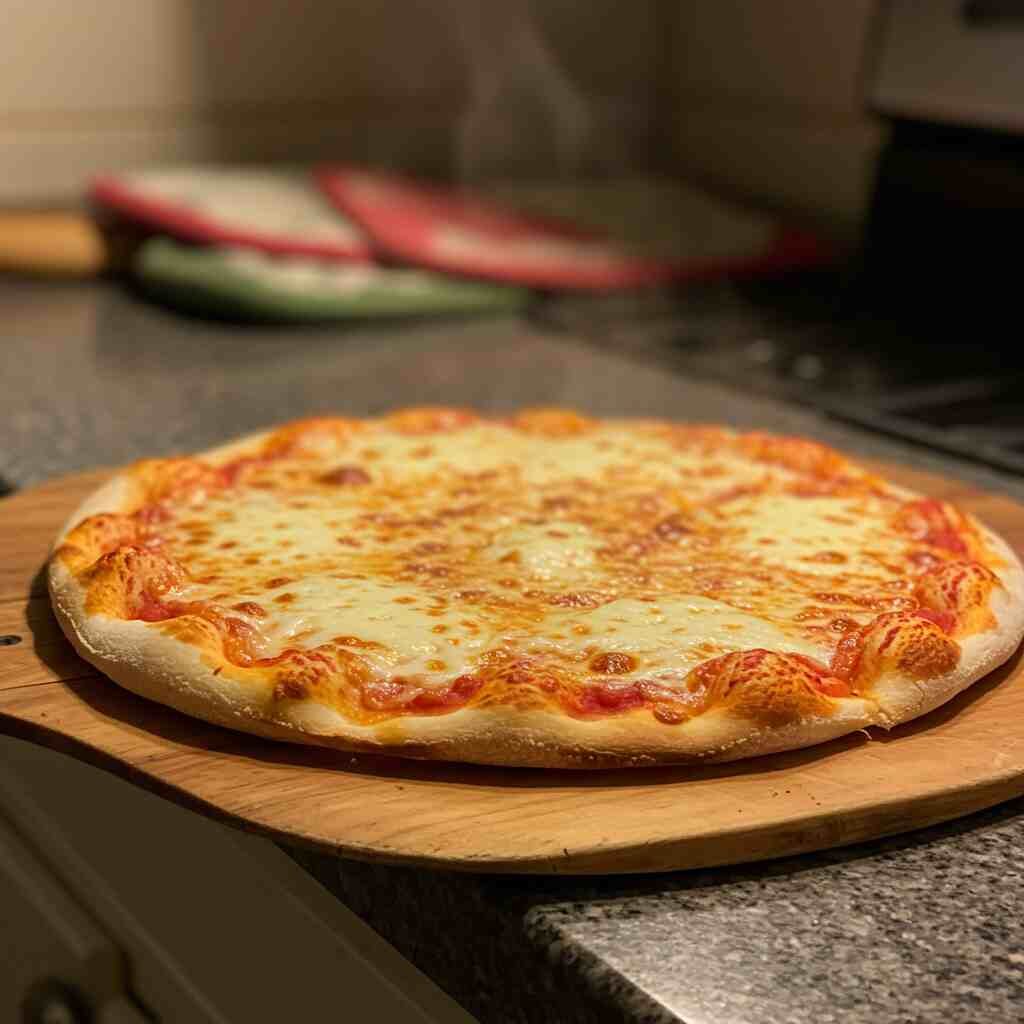
- Solution: Lower your oven temperature and bake longer
- Try placing your stone/steel higher in the oven
- Use less toppings in the center
Problem: Pale, soft crust
- Solution: Preheat your oven longer (45+ minutes)
- Use a pizza stone or steel instead of a pan
- Check that your oven actually reaches the set temperature
- Brush crust with olive oil for better browning
Problem: Dough sticks to the peel
- Solution: Build your pizza on parchment paper
- Use cornmeal or semolina flour under the dough
- Work quickly once dough touches the peel
- Shake the peel gently before each transfer to check for sticking
Problem: Soggy crust from wet toppings
- Solution: Pre-cook wet vegetables to remove moisture
- Drain fresh mozzarella for 30+ minutes on paper towels
- Use a thicker sauce or less sauce
- Consider par-baking the crust for 2–3 minutes first
Remember: even when making a gluten-free or classic King Arthur pizza dough recipe, consistent results come from careful oven setup, correct timing, and attention to detail.
Storing and Freezing King Arthur Pizza Dough
Short-term Storage Best Practices
You don’t need to use all your pizza dough at once. Proper storage keeps it fresh and ready when you want it. For short-term storage (1–5 days), the refrigerator works best—even for a classic King Arthur pizza dough recipe.
Follow these steps for refrigerator dough storage:
- Complete the kneading stage of your recipe
- Let the dough rise at room temperature for 30–60 minutes
- Divide into individual pizza portions (about 250g each)
- Shape each portion into a smooth ball
- Place each ball in its own container with a lid
- Leave some room for expansion (dough will continue to rise slowly)
- Refrigerate for up to 5 days
The best containers for dough storage:
- Round plastic containers with lids
- Glass food storage containers
- Plastic bags with room to expand (squeeze out air first)
- Covered bowls tightly wrapped with plastic
The dough will change during refrigeration. The first day, it rises and develops flavor. By days 3–5, it takes on sourdough-like qualities with more tang and complexity. Many pizza lovers prefer the taste of 3-day dough over fresh dough.
When you’re using refrigerated dough from your King Arthur pizza dough recipe, take it out 1–2 hours before baking. Cold dough fights back when you try to shape it. Room temperature dough stretches much easier.
Freezing for Long-term Storage
For long-term pizza dough storage, freezing works great. Frozen dough lasts up to 3 months with minimal quality loss—especially when you’re using a high-quality King Arthur pizza dough recipe.
Best practices for freezing pizza dough:
- Make your dough as the recipe directs
- Complete the kneading stage
- Let rise at room temperature for 30 minutes only
- Divide into individual pizza-sized balls
- Wrap each ball tightly in plastic wrap
- Place wrapped balls in freezer bags
- Press out all air before sealing
- Label with the date and dough type
- Freeze flat to maintain shape
The key to great frozen dough: freeze it during the early rising stage. This stops yeast activity at the perfect time. When you thaw the dough, the yeast wakes up and finishes rising.
To use frozen dough:
- Move from freezer to refrigerator 24 hours before use
- Take out of refrigerator 2–3 hours before baking
- Let come to room temperature on a lightly floured surface
- Shape and bake as normal
Whether fresh or frozen, a King Arthur pizza dough recipe delivers excellent texture and flavor. Using bread flour helps the dough retain its strength and chew after freezing.
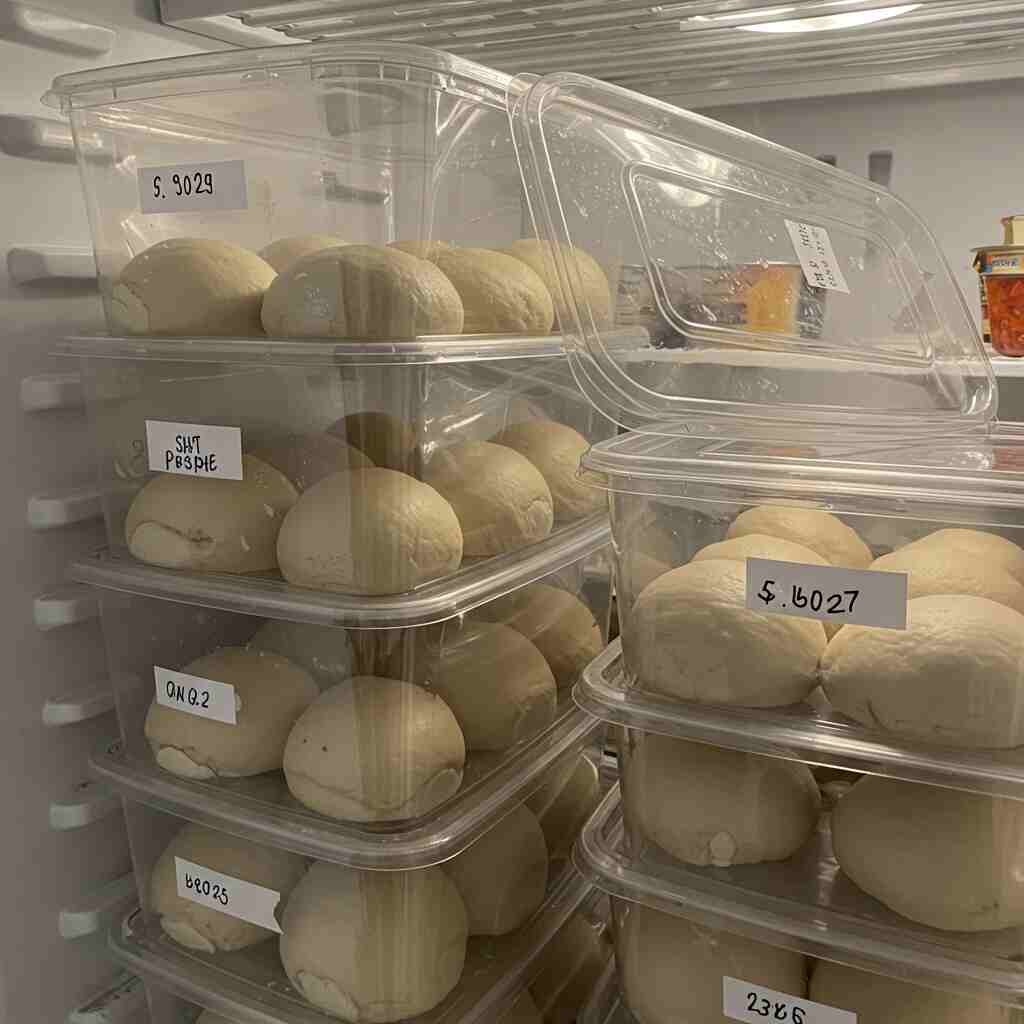
Make-Ahead Pizza Party Planning
Hosting a pizza party works better with advance planning. This timeline helps you prepare without last-minute stress—especially if you’re working from a large batch of King Arthur pizza dough recipe portions.
Three days before:
- Make a large batch of King Arthur pizza dough
- Divide into individual portions
- Refrigerate for flavor development
One day before:
- Prepare and refrigerate sauce
- Shred cheese and store in containers
- Chop toppings and store separately
- Set out equipment: peels, cutters, pans
Party day:
- Remove dough from refrigerator 2 hours before first pizza
- Preheat oven with stone/steel for at least 1 hour
- Set up toppings bar with all ingredients
- Take out only the dough you’ll use within 30 minutes
For a truly fun experience, prepare different dough types ahead of time:
- Regular King Arthur bread flour dough for traditional pizzas
- Higher hydration dough for pan pizzas
- Thin-crust dough for crispy options
- Gluten-free dough for those with dietary needs
Label each dough ball with the type so guests can choose their preference. It’s a fun way to showcase the versatility of a King Arthur pizza dough recipe lineup while keeping your prep organized.
Frequently Asked Questions
What is in King Arthur’s pizza dough flavor?
King Arthur’s pizza dough flavor enhancer contains:
Dried cheese (including parmesan and romano)
Garlic powder
Salt
Dried herbs (oregano, basil, thyme)
Natural enzymes that improve texture
Ascorbic acid (helps dough rise better)
You can make a simple version at home by adding:
1 tablespoon grated parmesan cheese (dried)
1 teaspoon garlic powder
1 teaspoon dried oregano
½ teaspoon dried basil
¼ teaspoon dried thyme
Mix these into your dry ingredients before adding water. While not identical to the commercial product, this blend adds similar flavors to your homemade dough.
The commercial flavor also contains dough improvers that home bakers can’t easily replicate. These help commercial bakeries get consistent results. For home bakers working with a King Arthur pizza dough recipe, proper technique matters more than special additives.
Which King Arthur Flour Is Best for Pizza Dough?
Choosing the best flour for your King Arthur pizza dough recipe depends on the pizza style you’re aiming for. Different flours offer varying protein levels, which influence texture, chew, and stretchability.
King Arthur Bread Flour (12.7% protein)
Ideal for chewy, foldable New York-style crusts
Builds strong gluten networks to support heavy toppings
Excels in long, cold fermentation for deeper flavor
Produces the most classic pizzeria-style texture in your King Arthur pizza dough recipe
King Arthur All-Purpose Flour (11.7% protein)
Balanced crust with a mix of chew and crispness
Suitable for most home pizza styles
Easier to stretch and shape than bread flour
A great all-around choice for any King Arthur pizza dough recipe
King Arthur 00 Pizza Flour (11.5% protein)
Best for thin, Neapolitan-style pizzas
Delivers a tender bite and lightly crisp exterior
Bakes fast at high heat for authentic results
The go-to flour for a classic Italian King Arthur pizza dough recipe
King Arthur Italian-Style Flour (8.5% protein)
Produces crisp, delicate thin crusts
Perfect for cracker-style or Roman-style pizza
Easy to roll out thin without much resistance
Adds refinement to lighter King Arthur pizza dough recipe styles
Pro Tip: Many experienced bakers blend flours for customized results. For example, mix 50% bread flour with 50% all-purpose for a crust that combines chew with tenderness—an excellent base for a versatile King Arthur pizza dough recipe.
What Is the Secret to Making Good Pizza Dough?
The foundation of a successful King Arthur pizza dough recipe lies in technique and precision. Here are professional tips that make all the difference:
Measure by Weight
Use a digital scale for accuracy
Cup measurements are inconsistent
Weight-based recipes produce consistent dough every time
Control Your Water Temperature
Cold water (55–65°F) = slow fermentation, more flavor
Warm water (95–105°F) = faster rise, same-day pizza
Temperature management is crucial for a great King Arthur pizza dough recipe
Don’t Rush Fermentation
Let your dough ferment at least 24 hours in the fridge
Cold fermentation builds flavor and better structure
A patient King Arthur pizza dough recipe always yields superior results
Handle Dough Gently
Avoid pressing out air pockets
Use fingertips, not palms, when shaping
Let dough rest if it’s resisting stretch
Maximize Oven Heat
Preheat for 45+ minutes
Use a baking stone or steel for even browning
Add steam (e.g., water spray or ice cubes) to enhance crust texture
Hydration Is Everything
Start with 60–62% hydration for best balance
Higher hydration = more open crumb and big bubbles
Lower hydration = denser, more traditional crust
Adjust hydration gradually to perfect your King Arthur pizza dough recipe
What Is the 55 Rule for Pizza?
The “55 rule” refers to using 55% hydration in your pizza dough—a great starting point for beginners using a King Arthur pizza dough recipe.
Baker’s Math Formula:
Water weight ÷ Flour weight × 100 = Hydration %
Example: 275g water ÷ 500g flour × 100 = 55% hydration
Why 55% Works Well:
Dough is easier to handle
Less sticky and more forgiving
Simple to stretch without tearing
Performs reliably in standard home ovens
Hydration Ranges for Pizza Dough:
55–60%: Traditional, easy-to-handle dough
60–65%: Slightly open crumb with better airiness
65–70%: Artisan-style, large air pockets
70%+: Wet and sticky, advanced handling required
As your confidence with your King Arthur pizza dough recipe grows, gradually increase hydration by 2–3% at a time to fine-tune the texture and crust performance.
Expert Tips and Tricks
These professional pizza tips will take your King Arthur pizza dough recipe to the next level:
Autolyse the Dough
- Mix flour and water only, wait 20 minutes, then add salt and yeast
- This rest period jumpstarts gluten development
- Results in easier kneading and better structure
Autolysing is especially useful when working with a King Arthur pizza dough recipe using bread or all-purpose flour, as it enhances elasticity and hydration.
Use the Windowpane Test
- Stretch a small piece of dough – if you can see light through it without tearing, it’s ready
- This visual check works better than timing your kneading
- Perfectly kneaded dough makes better pizza
This is a simple way to ensure your King Arthur pizza dough recipe has developed the right gluten strength before shaping.
Add Flavor to Your Crust
- Replace 1/4 cup water with olive oil for richer flavor
- Add 1–2 tablespoons honey for better browning
- Mix herbs into the dough rather than just on top
Even a basic King Arthur pizza dough recipe can be customized with these flavor enhancements to create a signature crust.
Create Steam in Your Oven
- Spray the oven walls with water just before loading pizza
- Place ice cubes in a pan on the bottom rack
- Steam helps create better initial rise and crust texture
Though more common in bread baking, steam can enhance the texture of your King Arthur pizza dough recipe, giving it an artisan-style crust.
Perfect Your Transfer Technique
- Build pizza on parchment paper for easy sliding
- Use a wooden pizza peel dusted with cornmeal
- Practice the quick “jerk” motion that releases dough from peel
Perfecting your transfer technique ensures your King Arthur pizza dough recipe ends up in the oven intact and beautifully shaped.
Conclusion
Making amazing homemade pizza with King Arthur flour brings satisfaction few other cooking projects can match. The journey from simple ingredients to perfect pizza teaches valuable baking skills that apply to many other recipes.
Start with the basic techniques in a trusted King Arthur pizza dough recipe, then play with variables like hydration, fermentation time, and flour types to find your personal perfect pizza. The beauty of making pizza at home? You control every element—from the chewiness of the crust to the blend of toppings—creating pizza that matches your exact taste.
Remember these key points:
- Use weight measurements for consistency
- Cold fermentation creates the best flavor
- The right flour matters for your preferred style
- Proper oven setup makes a huge difference
- Practice improves your results every time
Pizza making combines science, art, and passion. With King Arthur’s quality flours and the techniques in this guide, your King Arthur pizza dough recipe will deliver results that rival your favorite pizzeria. The most important ingredient? The joy you bring to the process.
Discover More Meal Inspiration on Pinterest
Looking for even more recipe inspiration beyond what you find on ToDaRecipes? Pinterest is a goldmine for food lovers and home cooks alike. Whether you’re searching for seasonal dishes, dinner ideas, or quick 30-minute meals, Pinterest offers endless visuals and recipe boards to spark your creativity in the kitchen.
From viral trends like baked feta pasta to healthy meal prep ideas, you’ll find something to match every taste and diet. We especially recommend browsing collections filled with comforting classics and modern twists.
👉 Follow us on Pinterest for more easy and delicious recipes updated daily!
Using platforms like Pinterest alongside recipe blogs helps you stay inspired, organized, and excited to try something new every week.


